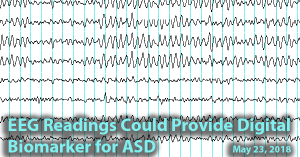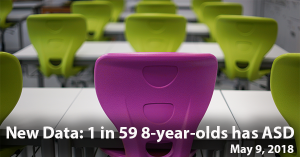Archives
May, 2018
Select a different month in the archive
Inexpensive Brain Scans Could Predict Autism Spectrum Disorder
By Chelsea Toledo, M.A. on May 23, 2018

Background: A reliable biomarker for early detection of autism is critical. Electroencephalography (EEG), a technique for recording and mapping electrical activity in the brain – could provide such a measure. During this non-invasive and relatively inexpensive procedure, small metal discs called electrodes are placed on the scalp to detect fluctuations in the voltage given off by the brain’s neurons over time.
What’s New: In a new study, researchers assessed whether EEG data could accurately predict emergence of Autism Spectrum Disorder (ASD) in very young children. They performed EEG procedure on 99 high-risk children (defined as having an older sibling with ASD) and 89 age-matched controls up to seven times, beginning when the children were as young as 3 months old and ending when the children were 3 years old.
The researchers found:
- Patterns in EEG data allowed researchers to predict nearly 100 percent of ASD cases prospectively diagnosed using the Autism Diagnostic Observation Schedule (ADOS) at either 18, 24, or 36 months of age.
- The EEG data also helped predict the severity of ASD as early as 3 months of age.
- Significant differences were evident between the EEG data of the high-risk versus the low-risk group. These differences were most pronounced at 12 months of age.
Why it’s important: This study suggests that EEG could be a useful tool, along with behavioral analyses, for diagnosing ASD early. Research has shown that early diagnosis is associated with improved outcomes for children with ASD.
Help me understand :
| Source(s) : |
| Tweet |
CDC Data Show Increase in Autism Diagnosis
By Chelsea Toledo, M.A. on May 9, 2018

Background: The U.S. Centers for Disease Control and Prevention, or CDC, regularly monitors communities to make estimates of the prevalence of Autism Spectrum Disorder (ASD) among children across the country. In 2016, the CDC estimated ASD prevalence of one in 68 for 8-year-olds based on data collected from 2010 to 2012. Prior to that, the prevalence among 8-year-olds was estimated to be one in 150.
What’s New: The latest CDC data – collected in 2014 – provide a new estimate for the prevalence of ASD among 8-year-old children: one in 59. To arrive at this figure, the researchers reviewed the records of more than 300,000 children in 11 states.
The researchers found:
- The overall prevalence of ASD in 2014 was 16.8 per 1,000 – or one in 59 – in the sites surveyed.
- That proportion provides a rough estimate for autism prevalence in the country; however, the results are not entirely generalizable as they come from only 11 sites.
- The median age at which members of the sample group received an ASD diagnosis was 4 years and 4 months – down slightly from 4 years and 5 months in previous years.
- The ratio of boys to girls receiving ASD diagnoses decreased slightly – from 4.5:1 in 2002-2012 to 4:1 in 2014.
- While white children continue to have higher rates of ASD diagnoses than their black and Hispanic peers, that difference became less pronounced in 2014.
Why it’s important: The continued increase in ASD prevalence among children raises a major concern for clinicians and researchers alike. However, the leveling of diagnosis rates among various groups – boys versus girls, white versus minority children – suggests that ASD diagnosis may be improving among previously underrepresented groups. Further surveillance is needed to determine the factors contributing to ASD prevalence increases.
Help me understand :
| Source(s) : |
| Tweet |

